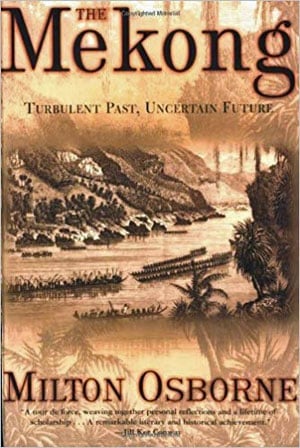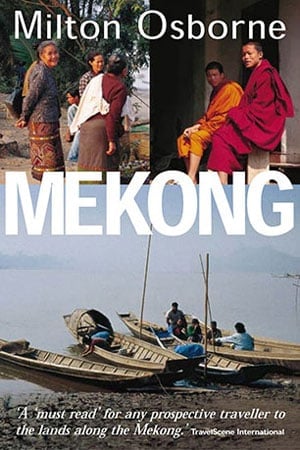
Despite its rather modest size, this book is a standard work must read for anyone interested in the turbulent but oh so rich and fascinating history of Southeast Asia. The Mekong is the compelling and very vividly told story of the peoples and cultures along one of the most famous - most notorious rivers on this continent. The Mekong is not just a river, but a stream loaded with myths and history. The river rises high on the Roof of the World, in the eternal snow on the Tibetan plateau near Chamdo and flows through the People's Republic of China, Burma, Laos, Thailand, Cambodia and Vietnam and then flows delta-wise after 4909 km in the South -China Sea. This mighty stream is, as the author rightly states, the lifeblood of the region that gave birth to and buried civilizations and cultures.
The Mekong' is an intriguingly written book that takes the reader not only on a geographical journey but also through time. It narrates the rise and fall of mythical civilizations like Funan, Chenia, and other Khmer, Thai, or Vietnamese empires that were engulfed in the mists of time. But the author also cleverly uses a number of protagonists to compellingly sketch the fascinating story of the stream. From Chou Ta-kuan, an envoy from the Chinese imperial court who celebrated the glories of the Khmer Empire of Angkor in the thirteenth century, to the adventure-hungry sixteenth-century Iberian freebooters Blais Ruiz and Diego Veloso, to Ho Chi Minh, who history of Vietnam changed dramatically. The reader follows in the footsteps of the enterprising Dominican father and missionary Gaspar de Cruz, the first European who ever - in 1555 - sailed the Mekong or follows the French explorer Henri Mouhot who made Angkor Wat world famous.

This work is, in my humble opinion, much more than an average travel guide. The Mekong is an exceptionally well-documented, but above all a compellingly told story. You guessed it: an absolute must for which I run out of superlatives…
For those after reading The Mekong still hunger for leather I still can River Road to China, highly recommend another book by Osborne. This work meticulously reproduces the heroic effort of the two French explorers Doudart de Lagrée and Francis Garnier; who left Saigon on June 5, 1866 with the intention of following the Mekong into China to explore and map a cross-river outcrop of the Middle Kingdom.
The Mekong: Turbulent Past, Uncertain Future by Milton Osborne, Grove Press, ISBN: 978 – 0802138026 Hardcover $19,98


The Mekong, lifeline for many countries, a source of international tensions as China deals with it through the unilateral construction of 8 dams in this river!
In Thai it is แม่น้ำโขง (mâe:-náam-kǒong, falling tone, high tone, rising tone). mâe:-náam is a title for large rivers. According to Wikipedia, Kǒong is a corruption of Chinese, which also means 'river'. In Thai, Kǒong is also alligator.
Statement:
https://www.thaipod101.com/learningcenter/reference/dictionary/แม่น้ำโขง
์May I add something, dear Rob V.?
Mae means 'mother'. (name is of course 'water'). The word occurs in many place names and in other combinations. Mae Sai in Northern Chiang Rai. Mae Thap means 'army commander'. Mae in this case is a title 'principal, honored, beloved', comparable to Father Drees and Mother Teresa. So Mae nam does not mean 'Mother of the Water' but simply 'The Grand Water', the 'River'.
I always just say mekong river, and everyone always understands what I mean by that. Just in normal pitch.
Bought this book after a previous post and I found it very interesting. As a follow-up to that, I read the book 'Last days of the mighty Mekong' by Brian Eyler, which is a few years more topical. The title is a bit apocalyptic, but the book certainly also outlines bright spots. Above all, it gives a, in my subjective opinion, a fairly nuanced picture of all activities in the Mekong basin and what consequences this has for primarily the inhabitants of that area.
I suspect that China is preparing for a shortage of water from the Himalayas and is building up a huge supply of water.
The Himalayan Ice Sheet is melting at a rapid rate, and when it melts, all of Asia will become a thirsty continent.
Yes, Ruud, and you have already been able to read that here.
https://www.thailandblog.nl/achtergrond/de-smeltende-derde-pool-ook-thailand-voelt-de-pijn/
The third pole is melting and the supply of drinking water can therefore decrease sharply. But also the water for irrigation. The consequences could lead to refugee flows of unprecedented magnitude.
See what the river means to Thailand; well it is a river that drains water, I have not seen pumps anywhere where I see people taking water from the river, but I do see rivers and streams that flow into it. In addition, with global warming it will rain more and Thailand will have even more water. The fact that the glaciers in the Himalayas are shrinking is a problem for other countries but not for Thailand. Take a look when the water is lower and then the 'mighty' Mekong is no longer worth much. Thailand has enough water from precipitation and except for the immediately adjacent plots, you will not hear anyone saying that they no longer see water. That thirst certainly does not apply to Thailand and other tropical countries where a lot of precipitation falls because, as mentioned, there is an oversupply of water and the Mekong provides drainage.
Ger, come and have a look at the flood plains of the Mekong near Nongkhai. There you do see irrigation with pumps from the river for the very dry land that has arisen there. Yes, only in the dry season, of course.
As for the discharge, it is seriously hindered, and is only increasing, by the 100 built, under construction and planned dams in river and feeding tributaries. Read something about the Mekong Delta in the south of Vietnam where, due to the reduced supply of Mekong water, seawater enters the delta and makes rice cultivation impossible because rice likes fresh water at the roots.
The Mekong has long ceased to be a mighty river. At the beginning of this century, it regularly happened in the months of July and August that the Mekong in Nongkhai was so high that the city discharges had to be closed to prevent the city from being flooded. The advantage of those dams is that this no longer occurs…
Yes, how far does that pumping go, only for the adjacent plots, surely not for a kilometer away or even 10 km. All marginal and irrelevant. 2 years ago, a plan from 20 years ago was dusted off, but now it appears that the water flow is already too little to realize plans for irrigation. It is already too late because China and Laos control the water supply and now there is not enough to start large-scale irrigation projects with water from the Mekong.
Look at an article from the Bangkok Post about a grand but outdated (by checkers) plan:
https://www.bangkokpost.com/thailand/general/1709335/govt-revives-old-plan-to-irrigate-isan